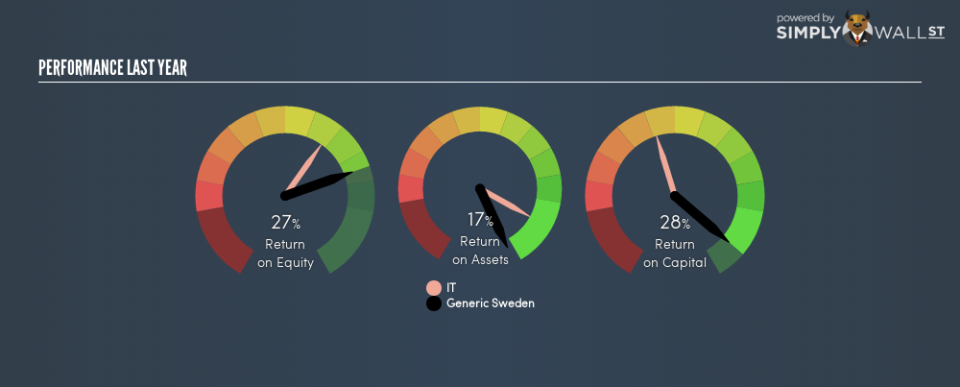Are Generic Sweden AB’s (STO:GENI) High Returns Really That Great?

Today we’ll look at Generic Sweden AB (STO:GENI) and reflect on its potential as an investment. Specifically, we’ll consider its Return On Capital Employed (ROCE), since that will give us an insight into how efficiently the business can generate profits from the capital it requires.
First of all, we’ll work out how to calculate ROCE. Next, we’ll compare it to others in its industry. Finally, we’ll look at how its current liabilities affect its ROCE.
Understanding Return On Capital Employed (ROCE)
ROCE measures the amount of pre-tax profits a company can generate from the capital employed in its business. Generally speaking a higher ROCE is better. In brief, it is a useful tool, but it is not without drawbacks. Author Edwin Whiting says to be careful when comparing the ROCE of different businesses, since ‘No two businesses are exactly alike.’
How Do You Calculate Return On Capital Employed?
Analysts use this formula to calculate return on capital employed:
Return on Capital Employed = Earnings Before Interest and Tax (EBIT) ÷ (Total Assets – Current Liabilities)
Or for Generic Sweden:
0.28 = kr4.9m ÷ (kr41m – kr9.1m) (Based on the trailing twelve months to September 2018.)
Therefore, Generic Sweden has an ROCE of 28%.
See our latest analysis for Generic Sweden
Want to help shape the future of investing tools and platforms? Take the survey and be part of one of the most advanced studies of stock market investors to date.
Does Generic Sweden Have A Good ROCE?
When making comparisons between similar businesses, investors may find ROCE useful. We can see Generic Sweden’s ROCE is around the 24% average reported by the IT industry. Setting aside the comparison to its industry for a moment, Generic Sweden’s ROCE in absolute terms currently looks quite high.
As we can see, Generic Sweden currently has an ROCE of 28% compared to its ROCE 3 years ago, which was 10.0%. This makes us think the business might be improving.
When considering ROCE, bear in mind that it reflects the past and does not necessarily predict the future. ROCE can be deceptive for cyclical businesses, as returns can look incredible in boom times, and terribly low in downturns. ROCE is, after all, simply a snap shot of a single year. Since the future is so important for investors, you should check out our free report on analyst forecasts for Generic Sweden.
Generic Sweden’s Current Liabilities And Their Impact On Its ROCE
Liabilities, such as supplier bills and bank overdrafts, are referred to as current liabilities if they need to be paid within 12 months. The ROCE equation subtracts current liabilities from capital employed, so a company with a lot of current liabilities appears to have less capital employed, and a higher ROCE than otherwise. To check the impact of this, we calculate if a company has high current liabilities relative to its total assets.
Generic Sweden has total assets of kr41m and current liabilities of kr9.1m. Therefore its current liabilities are equivalent to approximately 22% of its total assets. The fairly low level of current liabilities won’t have much impact on the already great ROCE.
What We Can Learn From Generic Sweden’s ROCE
With low current liabilities and a high ROCE, Generic Sweden could be worthy of further investigation. Of course, you might find a fantastic investment by looking at a few good candidates. So take a peek at this free list of companies with modest (or no) debt, trading on a P/E below 20.
I will like Generic Sweden better if I see some big insider buys. While we wait, check out this free list of growing companies with considerable, recent, insider buying.
To help readers see past the short term volatility of the financial market, we aim to bring you a long-term focused research analysis purely driven by fundamental data. Note that our analysis does not factor in the latest price-sensitive company announcements.
The author is an independent contributor and at the time of publication had no position in the stocks mentioned. For errors that warrant correction please contact the editor at editorial-team@simplywallst.com.


